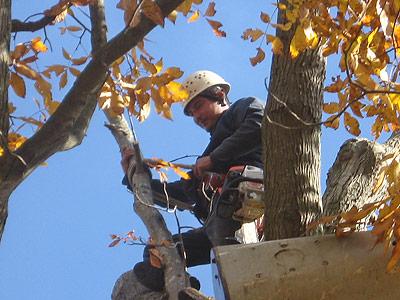To Protect Life, Limbs, And Trees

Tropical Storm Irene left many trees in her wake when she ran across the South Fork on Aug. 28. While the damage could have been far worse, arborists have been quite busy since then tackling all the cleanup.
There is no way to compete with Mother Nature, especially when you are up against 60 to 70-mile-per-hour winds, but some local tree-care specialists have offered a few tips for protecting your property next time around.
Michael Gaines, founder and president of CW Arborists in East Hampton strongly recommends that homeowners have a qualified person inspect their property annually for signs of rotting, decay, and diseased or dead trees, so that any hazardous ones can be removed prior to a storm.
And when it comes to post-storm cleanup, Mr. Gaines, a master arborist certified by the International Society of Arboriculture, said the most important thing is to have a professional assess the situation and take action. “There are a lot of different methods to remove a tree, if a tree has fallen on a house. Sometimes a crane is perfect, or a cut is the right way to go. You can crush the house if you make the wrong cut,” said Mr. Gaines. “Gravity, torsion, compression, all of these forces are compounded when a tree falls,” he said.
And, those who need tree work done after a storm should make sure their arborist is legit, he said. “Insurance goes for the deepest pocket. If you’re going for cheap labor [and something happens], the homeowner is responsible. It’s safety. You have to ask yourself, ‘Is it worth it?’ ”
Bad cuts can further damage trees that can be saved, he said. “I take it personally because these are some wonderful trees that I’ve known my whole life. When I’m talking about a tree, I’m talking the next 40 to 50 years, they need to be maintained.”
Prevention and awareness are half the battle. According to Mica Marder, owner of Mica Marder Landscaping in East Hampton, good tree maintenance and good pruning are crucial to tree health. “There are certain varieties of trees that don’t develop deep root systems. In East Hampton the elevation isn’t that high and lower elevation is usually something to worry about because you have a higher moisture content [in the soil] that can lead to root rot or softer ground, which results in a poor root system,” he said.
In addition to removing large dead branches near a house, Mr. Marder also recommends that homeowners be aware of the type of soil on their property. He cautions people against simply removing trees from their property in an attempt to protect their house. “Trees are a privilege to have on your property, and if you maintain proper tree care, your trees are better protected and less of a potential hazard during a storm,” he said.
If a tree is in wetlands or softer ground, then it is a more viable candidate for removal, he added. However, he pointed out that there are town restrictions regarding the percentage of a property that can be cleared.
Mr. Marder, too, advised having a professional survey a property in the aftermath of a big storm. “People will take chances, and the homeowner is responsible. Even if you think the tree is leaning one way, it doesn’t necessarily mean it’s going to go that way. There could be vines, there could be rot in the tree, all of which could cause the tree to go in an unpredictable fashion.”
“Our approach is trying to get our clientele to understand and practice a proactive approach to trees that are at risk,” said A.J. Remy of Remy Tree in Sag Harbor. “My business is based on pruning trees. We don’t practice chopping, we don’t top trees, but sometimes we have to do some canopy reduction, which develops an eye for natural pruning. We try to preserve trees.”
He also suggests that property owners diversify their plantings. “Mix it up. Don’t just plant one kind of tree across your property. Have a variety of texture, color, and flowering. It gives you a nice balance.”
Mr. Remy cautioned against employing tree workers who “might not understand the practice, and don’t get the union of the branches and the tree,” he said. “It’s really been hard this past week to see landscapers wielding chain saws like they’re cowboy jockeys.”
Next Thursday from 6 to 8 p.m., Mr. Gaines will offer a chain saw-safety class at CW Arborists at 194 Three Mile Harbor Road in East Hampton. It will be free and open to the public. “I’ve seen so many accidents and close calls, why not make it available?” he said. During the seminar, Mr. Gaines will demonstrate proper technique, the most dangerous parts of the saw, and how to protect the most at-risk parts of your body while operating a saw.
